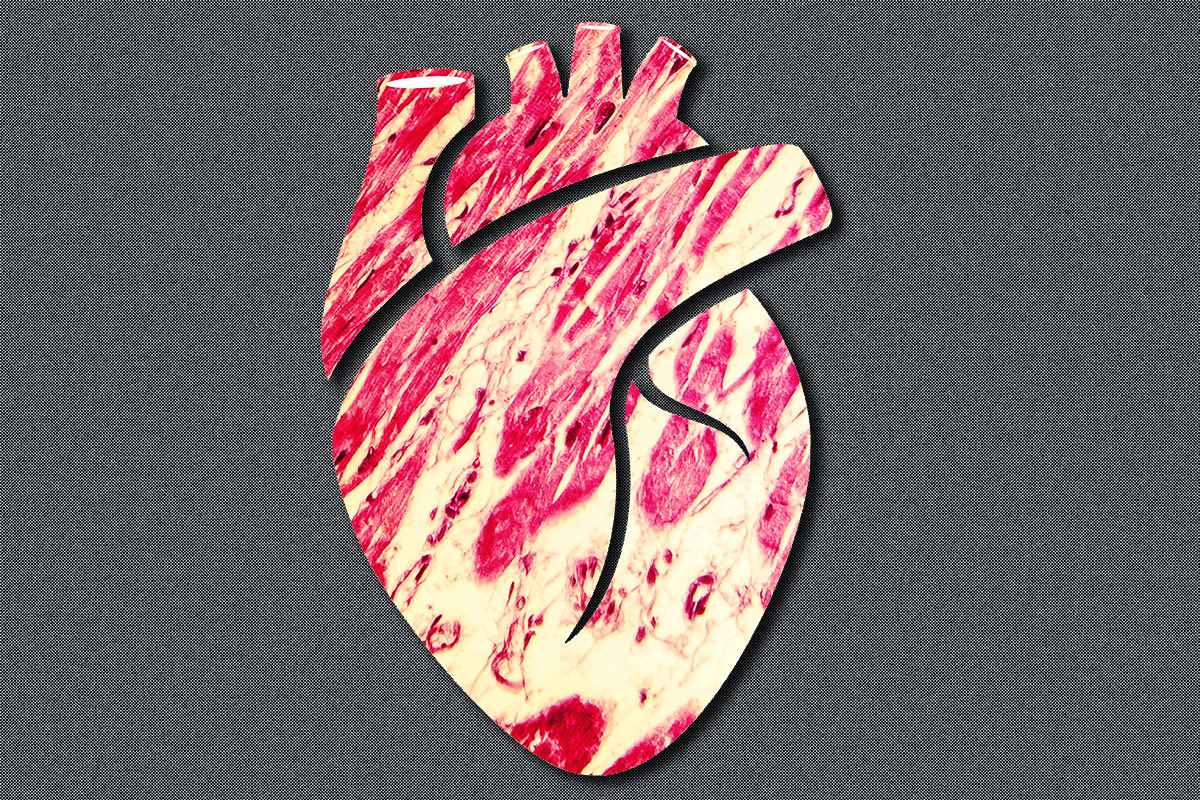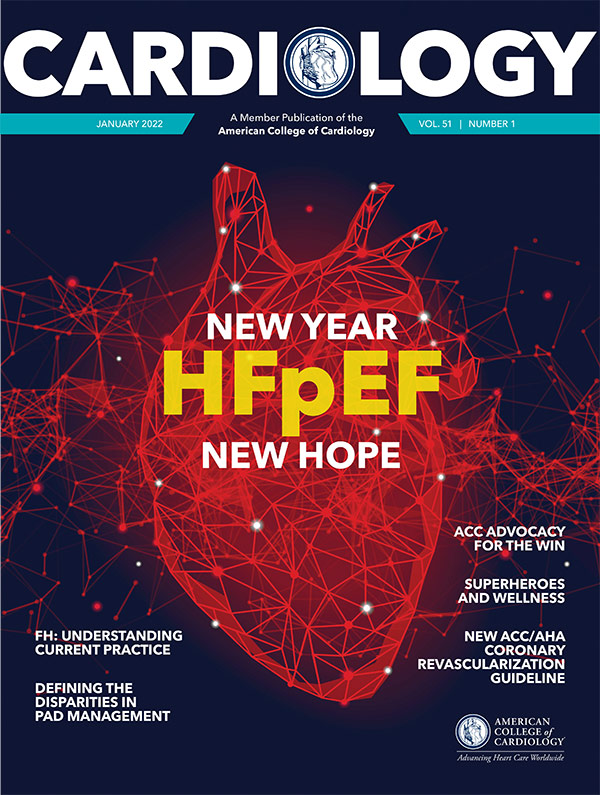Focus on Heart Failure | Heart Failure and Transplantation: Key Wins in 2021

Heart failure (HF) is the most dynamic field in cardiology. Important and memorable advances in HF, cardiomyopathies, mechanical circulatory support and cardiac transplantation were made in 2021. Here we highlight the most important contributions.
HF and Cardiomyopathy
The first data of the extent of cardiovascular involvement from COVID-19 emerged throughout 2021. Rigorous data collection and analysis of the outcomes has been required because of this novel infection. In terms of HF, we've learned that myocarditis due to coronavirus infection is not uncommon and mostly affects patients with advanced pulmonary infection. Pericardial effusion including tamponade is a common finding. Varying disease severity has been reported, including cardiogenic shock, which developed in about one-third of the patients, and in some cases requiring short-term mechanical circulatory support.
Regarding therapies for HF, we've seen several major breakthroughs. It's not every year that an entire new class of pharmaceuticals enters this arena, but happily this happened in 2021 – which was dubbed the year of myosin modulators. Two clinical trials with myosin modulators, presented last year, produced important outcomes in two completely different conditions.
Omecamtiv mercabil, a selective cardiac myosin activator which increases the duration of systole, was tested in GALACTIC-HF, a multicenter, randomized, controlled trial. It was found that in 8,256 randomly assigned patients with HF and reduced left ventricular ejection fraction (LVEF; <35%) on good background medical therapy, omecamtiv mercarbil (25 mg, 37.5 mg or 50 mg twice daily) vs. placebo reduced the primary composite endpoint of time to first HF event or cardiovascular death (hazard ratio [HR], 0.92; 95% confidence interval [CI], 0.86 to 0.99; p=0.025). Median follow-up was for 21.8 months. Importantly, as EFs decreased, there was a greater relative and absolute treatment effect. The absolute risk reduction in the lowest quartile was 7.4 events per 100 patient-years, vs. no reduction in the highest quartile. The number needed to treat for three years was 11.8 in the lowest quartile. There was a progressive decrease in NT-proBNP. Serious adverse events were similar between treatment groups.
The second trial enrolled patients with hypertrophic obstructive cardiomyopathy (HCM). Mavacamten, a targeted inhibitor of cardiac myosin that reduces the number of myosin-actin cross-bridges and decreases cardiac contractility, appeared to be a novel treatment for this condition. HCM-Explorer was a phase 3, randomized, double-blind, placebo-controlled trial that enrolled patients with HCM and an LV outflow tract gradient ≥50 mm Hg and NYHA class II–III symptoms. Patients on mavacamten had greater reductions than those on placebo in post-exercise LV outflow tract gradient (–36 mm Hg; 95% CI –43.2 to –28.1; p<0.0001), a greater increase in peak VO2 on exercise as well as improved symptoms. In the mavacamten group, 34% more patients improved by at least one NYHA class (80 of 123 patients vs. 40 of 128 patients in the placebo group; 95% CI, 22.2 to 45.4; p<0.0001). Safety and tolerability were similar with placebo.
Last year there were also important trials further exploring the role of sacubitril/valsartan. The PARALLAX trial was designed to test the hypothesis that sacubitril/valsartan is more effective than background therapy (enalapril, valsartan or placebo) in reducing NT-proBNP levels and improving submaximal exercise capacity and quality of life in patients with chronic HF and LVEF >40%. And indeed, reductions in NT-proBNP levels in the sacubitril/valsartan group were evident as early as Week 4 and remained lower than levels in the other arm at Week 24. There was no difference in the 6-minute walk distance.
Unfortunately, neither PARADISE-MI, comparing sacubitril/valsartan with an ACE inhibitor, initiated in the early period after acute myocardial infarction (MI) in the presence of decreased EF, nor the LIFE trial, testing sacubitril/valsartan vs. valsartan in patients with advanced HF, demonstrated any advantages of sacubitril/valsartan.
In contrast, SGLT2 inhibitors, already well established in HF with reduced LVEF, gained significant ground in patients with preserved ejection fraction (HFpEF). In 2021, the EMPEROR-Preserved, a randomized, double-blind, parallel-group, placebo-controlled, event-driven trial that randomly assigned 5,988 patients with class II–IV HF and an EF >40% to receive empagliflozin or placebo, in addition to usual therapy. Over a median follow-up period of 26.2 months, a primary outcome event, a composite of cardiovascular death or hospitalization for HF, occurred in 13.8% of the empagliflozin group and in 17.1% of the placebo group (HR, 0.79; 95% CI, 0.69 to 0.90; p<0.001). This effect was mainly related to a lower risk of hospitalization for HF with empagliflozin. The effects of empagliflozin appeared consistent in patients with or without diabetes. The total number of hospitalizations for HF was lower with empagliflozin vs. placebo (407 vs. 541; HR, 0.73; 95% CI, 0.61 to 0.88; p<0.001). Uncomplicated genital and urinary tract infections and hypotension were reported more frequently with empagliflozin. The positive news for patients with HFpEF was eagerly awaited. Moreover, these results could be the first drug class effect with an efficacy that spans the spectrum of EFs. Another trial, EMPULSE demonstrated clinical benefits in patients hospitalized with acute HF. (For more on the emerging role of SGLTs in HF, see this month's cover story.)
Nonpharmaceutical interventions are also important. The value of physical activity in HF is empirically valued with scanty evidence, but a new clinical study reported last year provided some insights.
REHAB-HF was a multicenter, controlled trial of 349 patients randomized to a tailored, progressive rehabilitation intervention that included four physical function domains (strength, balance, mobility, endurance) or usual care. More than half of patient had HFpEF and nearly all had an average of five comorbidities, including hypertension, diabetes, obesity, lung disease and kidney disease. Patients had markedly reduced physical function and at baseline 97% were frail or pre-fail. The intervention was initiated during, or early after, hospitalization for HF and was continued after discharge for 36 outpatient sessions.
At 12-weeks of follow-up, patients in the intervention group had significant improvements in physical function and quality of life in the Short Physical Performance battery, 6-minute walk test, Kansas City Cardiomyopathy Questionnaire and a depression survey. Although the study was not powered to look for clinical events, no statistically significant differences were seen between the two groups.
In terms of remote hemodynamic monitoring of the volume status of patients with HF with an implantable pressure sensor (CardioMEMS), the GUIDE-HF trial in its prepandemic phase showed reduction of hospital admissions for HF across the spectrum of LVEFs. After the COVID-19 national emergency declaration and subsequent public health measures resulted in an overall reduction in hospital admissions for chronic conditions in general and HF in particular, the outcomes of the whole trial were neutral.
Mechanical Circulatory Support
Another memorable event from 2021 is the withdrawal from the market of the Heartware ventricular assist device (VAD) by Medtronic, leaving clinicians with only one choice for a VAD, the HeartMate 3, and creating Abbott's monopoly on the market of durable VADs. The migration of the field towards HeartMate 3 started immediately after publication of MOMENTUM 3, which demonstrated superiority of HeartMate 3 over HeartMate II. Currently, HeartMate 3 provides a two-year survival of 83%, similar with survival post heart transplantation at the same time mark. Although HeartMate 3 was never tested against Heartware in a head-to-head comparison, the fully magnetically levitated design and other novel features of HeartMate 3 resulted in almost complete elimination of pump thrombosis as one of the major complications of longstanding support of the LV. It also appeared that the rate of stroke is lower on HeartMate 3. Some recalls for technical flaws of Heartware likely contributed to the decision of the company to completely pull the device from the market and to make it unavailable for new implants. The care is ongoing, however, for about 4,000 patients with a Heartware LVAD.
Cardiac Transplantation
The number of heart transplants in the U.S. is increasing every year. The new heart allocation system went into effect in October 2018 with the intent to improve the organ allocation to the sickest patients. The preliminary results from an initial analysis of the overall effect of this change, conducted in 2021, suggest there has been a reduction in the waitlist mortality in concert with a reduction in wait times for heart transplantation.
However, there has been an increase of about 20-30% in the use of temporary mechanical circulatory support, such as the intra-aortic balloon pump and extracorporeal membrane oxygenation, before transplantation because this confers a higher allocation status. On the other hand, in terms of overall one-year survival, a reduction (from 92.1% vs. 87.5%) to no change has been suggested by various reports. The decreased survival was attributed to longer ischemic times and transplanting sicker patients. Continued analysis and time will tell us about the pros and cons of this new allocation system.
Another advancement during 2021 was the continuation of noninvasive assessment of graft rejection. Rejection of the transplanted heart is one of the major complications leading to allograft loss and mortality. The gold standard for surveillance and screening of rejection has been endomyocardial biopsy. However, this is invasive, expensive and causes discomfort to patients, and it is associated with the procedural complications. The field is now moving towards noninvasive markers of graft injury such as cell-free donor-derived DNA assays, which is a blood test performed using routine phlebotomy. This test has a very high negative predictive value of 97-99% in low-risk patients. Combined with gene expression profiling assays, some centers have limited the endomyocardial biopsy to as low as two to four biopsies in the first year of transplantation in appropriate patients.
Newer organ preservation technology which provides a controlled environment for the procured organ, along with newer solutions for organ preservation to improve the quality of the donor organ and mitigate the injury are expected to increase the quality of the graft and decrease rejection.
Various centers are using donations after circulatory death instead of the traditional brain-dead donor. This has shown promising results and could potentially increase the donor pool by 15-30%. Use of hepatitis C donors and the favorable short-term results are encouraging with more centers adopting this strategy has expanded the donor pool as well.
The ongoing COVID-19 pandemic has a worse impact on heart and lung transplant patients with an increased mortality rate of about 20-30%. Morbidity is high as well with an increased hospitalization rate and need for mechanical ventilation for infected transplant patients. In 2021, we obtained the first results of the response to COVID-19 vaccines by transplanted patients: a suboptimal response was found, with a seroconversion rate of about 10-57% for humoral immunity and 10-70% cellular response after two doses of mRNA vaccines. The third (booster) dose significantly increased the humoral response, however the safety is unknown. Regardless of the suboptimal response, studies suggest a decreased mortality rate and less symptomatic disease in vaccinated patients. Unknown variables such as how to handle donors who are infected with COVID-19 and when to consider transplantation for patients infected with COVID-19 are some of the challenges that have left the transplant community with diagnostic dilemmas.



This article was authored by Onyedika J. Ilonze, MD, FACC, assistant professor of medicine at Indiana University (IU) School of Medicine in Indianapolis and an advanced heart failure and transplant cardiologist; Roopa A. Rao, MD, FACC, assistant professor of medicine at IU and the Krannert Institute of Cardiology; and Maya E. Guglin, MD, PhD, FACC, director of Heart Failure/Heart Transplantation/MCS Services at the Krannert Institute of Cardiology and professor of medicine at IU School of Medicine, and the chair of ACC's Heart Failure and Transplant Member Section.
Clinical Topics: Cardiac Surgery, Cardiovascular Care Team, COVID-19 Hub, Diabetes and Cardiometabolic Disease, Geriatric Cardiology, Heart Failure and Cardiomyopathies, Invasive Cardiovascular Angiography and Intervention, Pericardial Disease, Prevention, Aortic Surgery, Cardiac Surgery and Heart Failure, Acute Heart Failure, Heart Transplant, Mechanical Circulatory Support, Interventions and Structural Heart Disease, Exercise, Hypertension
Keywords: ACC Publications, Cardiology Magazine, Actins, Allografts, Angiotensin-Converting Enzyme Inhibitors, Arm, Biopsy, Brain Death, Cardiac Myosins, Cardiologists, Cardiology, Cardiomyopathies, Cardiomyopathy, Hypertrophic, Chronic Disease, Confidence Intervals, COVID-19, COVID-19 Vaccines, Depression, Diabetes Mellitus, DNA, Double-Blind Method, Enalapril, Environment, Controlled, Exercise, Exercise Tolerance, Extracorporeal Membrane Oxygenation, Follow-Up Studies, Frail Elderly, Gene Expression Profiling, Genitalia, Graft Rejection, Heart Failure, Heart Transplantation, Heart-Assist Devices, Hematologic Tests, Hemodynamic Monitoring, Hepatitis C, Hospitalization, Hospitals, Hypertension, Hypotension, Immunity, Humoral, Indiana, Kansas, Kidney Diseases, Lung Transplantation, Morbidity, Myocarditis, Myosins, Numbers Needed To Treat, Obesity, Organ Preservation, Outpatients, Pandemics, Patient Discharge, Pericardial Effusion, Pharmaceutical Preparations, Phlebotomy, Physical Functional Performance, Predictive Value of Tests, Public Health, Quality of Life, Respiration, Artificial, Seroconversion, Severity of Illness Index, Shock, Cardiogenic, Sodium-Glucose Transporter 2 Inhibitors, Stroke, Stroke Volume, Surveys and Questionnaires, Systole, Technology, Technology, Thrombosis, Tissue Donors, Universities, Urinary Tract Infections, Valsartan, Ventricular Function, Left, Waiting Lists, Walk Test
< Back to Listings

